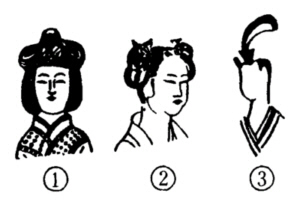Chapter 17 Section 4 Dressing
The hairstyles of Han women in this period are also very characteristic.Among some aristocratic women, a hair style called "covered bun" was once popular.It is actually a false bun with gold and silver jewelry inserted into the topknot.Most of these fake buns are very high, and sometimes they cannot be erected, so they have to be placed on both sides of the eyebrows and temples, matching with the fluffy temple hair, creating a special effect of grace and luxury, so there is a "slow temple bun" ("Book of Jin·Wu Xing Zhi" ") statement.There are strict regulations on the decorations used in the widow's chignon, which are classified according to the amount of gold tin.With the popularity of fake buns, the supply of human hair is in short supply, and the price of fake buns is quite expensive. Women from poor families cannot afford to buy them, so they have to ask others to borrow them, so there is a saying of "borrowing hair".It was in such an environment that Tao Kan's mother, a famous scholar in the Eastern Jin Dynasty, cut off her hair and sold money to buy wine because of her family's poverty and inability to entertain guests in her early years.

⑴Fake bun ⑵Double Huan bun ⑶Flying bun
The "Spiritual Snake Bun" combed by Empress Zhen of Wei Wen was also famous for a while.According to the "Cailan Magazine", after Zhen was brought into the Wei Palace, he often saw a green snake crawling around in his bedroom.Whenever Mrs. Zhen puts her makeup on, it will form a ball and appear next to Mrs. Zhen.Zhen felt that it was very strange, so she imitated its coiled shape and combed it into various bun styles.As a result, the hair bun is so ingenious and different every day that it is loved by the emperor and envied by the concubines.
At that time, ordinary women not only tied their hair into various bun styles, but also borrowed fake buns to increase their charm.But its structure is relatively simple, and gold tin jewelry cannot be used.There are also many women who imitate the women of ethnic minorities in the Western Regions, twisting their hair into a single bun (huanhuan) or double bun style, towering above their heads.There are also those who comb Yaji or Luoji.In the Southern Dynasties, influenced by the clothing of Buddhist figures, most women put buns in the center of their hair and combed them into a vertical ring style, so they were called "flying buns".In addition, there are also people who apply yellow on the forehead (named "forehead yellow"), dots on the center of the eyebrows (named "huadian"), put flowers on the sideburns or on the chest, wear bracelets on the wrists, or make them of gold, silver, and tortoiseshell. Axes, battle-axes, daggers, halberds and other shapes are used as Ji for decoration.

⑴Fake bun ⑵Double Huan bun ⑶Flying bun
